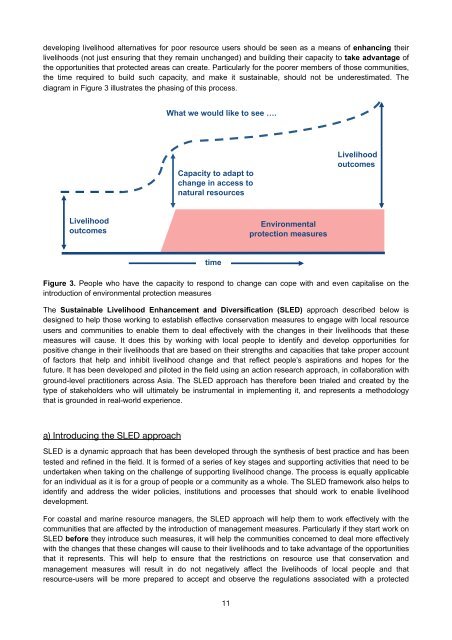Sustainable Livelihoods Enhancement and Diversification (SLED)
Sustainable Livelihoods Enhancement and Diversification (SLED)
Sustainable Livelihoods Enhancement and Diversification (SLED)
You also want an ePaper? Increase the reach of your titles
YUMPU automatically turns print PDFs into web optimized ePapers that Google loves.
developing livelihood alternatives for poor resource users should be seen as a means of enhancing their<br />
livelihoods (not just ensuring that they remain unchanged) <strong>and</strong> building their capacity to take advantage of<br />
the opportunities that protected areas can create. Particularly for the poorer members of those communities,<br />
the time required to build such capacity, <strong>and</strong> make it sustainable, should not be underestimated. The<br />
diagram in Figure 3 illustrates the phasing of this process.<br />
What we would like to see ….<br />
Capacity to adapt to<br />
change in access to<br />
natural resources<br />
Livelihood<br />
outcomes<br />
Livelihood<br />
outcomes<br />
Environmental<br />
protection measures<br />
time<br />
Figure 3. People who have the capacity to respond to change can cope with <strong>and</strong> even capitalise on the<br />
introduction of environmental protection measures<br />
The <strong>Sustainable</strong> Livelihood <strong>Enhancement</strong> <strong>and</strong> <strong>Diversification</strong> (<strong>SLED</strong>) approach described below is<br />
designed to help those working to establish effective conservation measures to engage with local resource<br />
users <strong>and</strong> communities to enable them to deal effectively with the changes in their livelihoods that these<br />
measures will cause. It does this by working with local people to identify <strong>and</strong> develop opportunities for<br />
positive change in their livelihoods that are based on their strengths <strong>and</strong> capacities that take proper account<br />
of factors that help <strong>and</strong> inhibit livelihood change <strong>and</strong> that reflect people’s aspirations <strong>and</strong> hopes for the<br />
future. It has been developed <strong>and</strong> piloted in the field using an action research approach, in collaboration with<br />
ground-level practitioners across Asia. The <strong>SLED</strong> approach has therefore been trialed <strong>and</strong> created by the<br />
type of stakeholders who will ultimately be instrumental in implementing it, <strong>and</strong> represents a methodology<br />
that is grounded in real-world experience.<br />
a) Introducing the <strong>SLED</strong> approach<br />
<strong>SLED</strong> is a dynamic approach that has been developed through the synthesis of best practice <strong>and</strong> has been<br />
tested <strong>and</strong> refined in the field. It is formed of a series of key stages <strong>and</strong> supporting activities that need to be<br />
undertaken when taking on the challenge of supporting livelihood change. The process is equally applicable<br />
for an individual as it is for a group of people or a community as a whole. The <strong>SLED</strong> framework also helps to<br />
identify <strong>and</strong> address the wider policies, institutions <strong>and</strong> processes that should work to enable livelihood<br />
development.<br />
For coastal <strong>and</strong> marine resource managers, the <strong>SLED</strong> approach will help them to work effectively with the<br />
communities that are affected by the introduction of management measures. Particularly if they start work on<br />
<strong>SLED</strong> before they introduce such measures, it will help the communities concerned to deal more effectively<br />
with the changes that these changes will cause to their livelihoods <strong>and</strong> to take advantage of the opportunities<br />
that it represents. This will help to ensure that the restrictions on resource use that conservation <strong>and</strong><br />
management measures will result in do not negatively affect the livelihoods of local people <strong>and</strong> that<br />
resource-users will be more prepared to accept <strong>and</strong> observe the regulations associated with a protected<br />
11
















